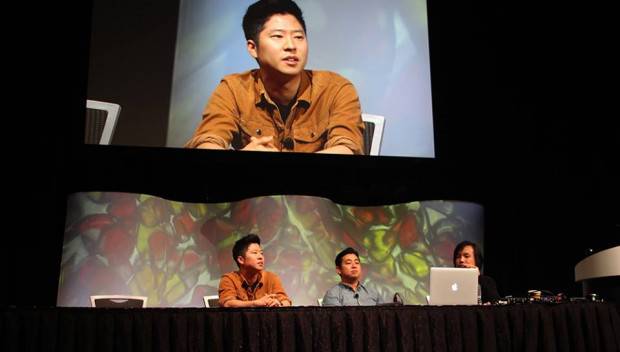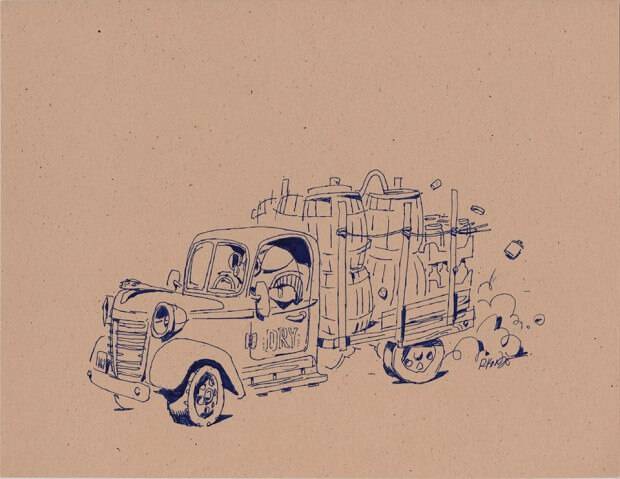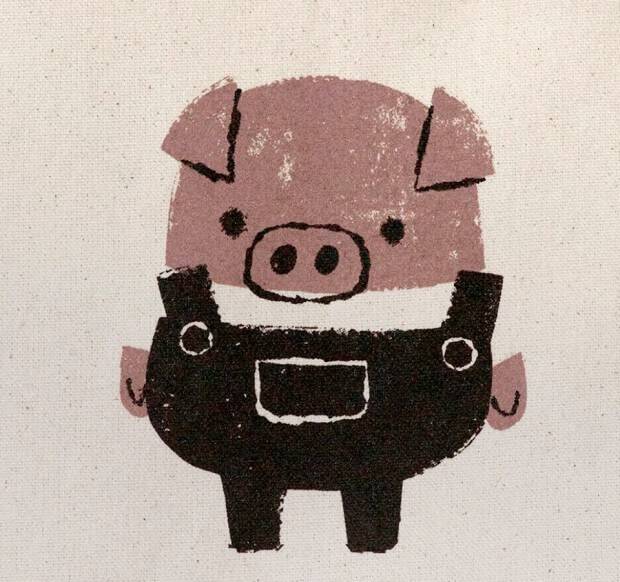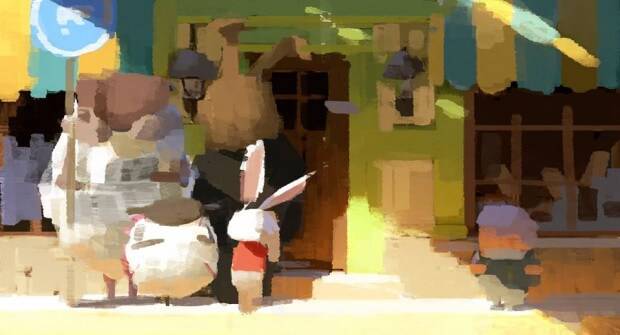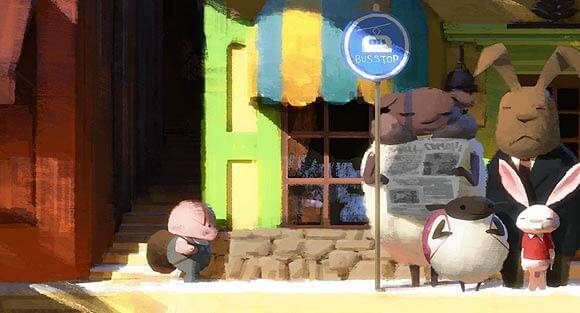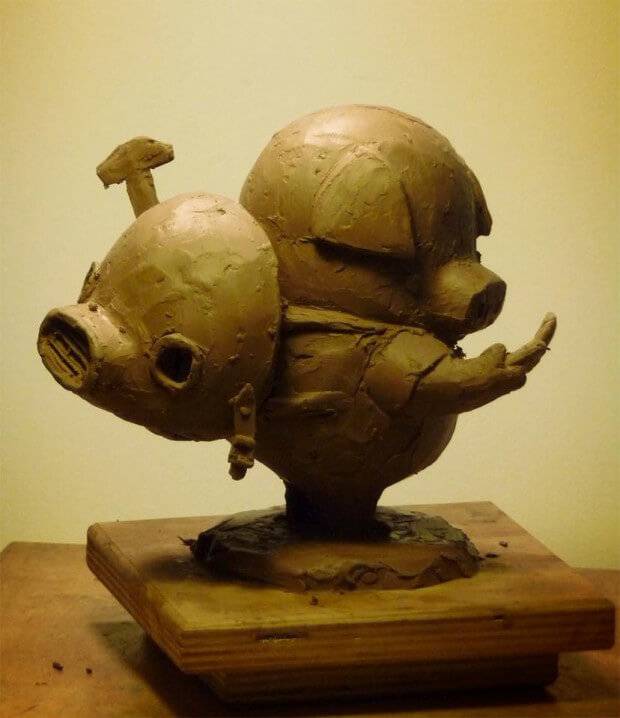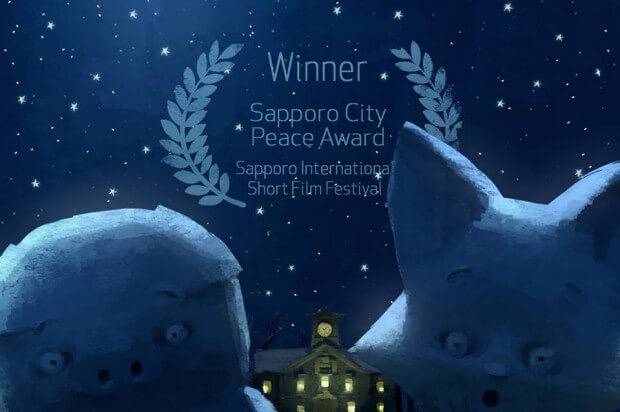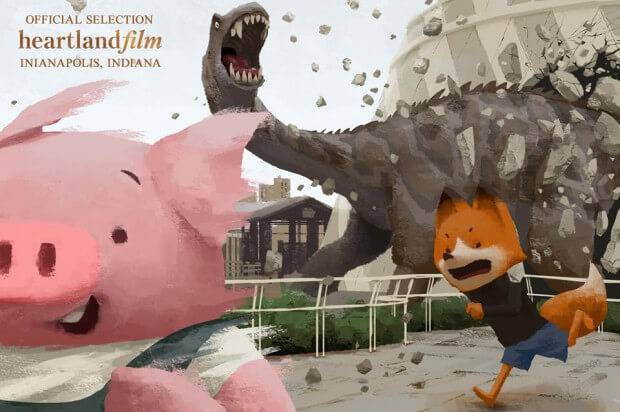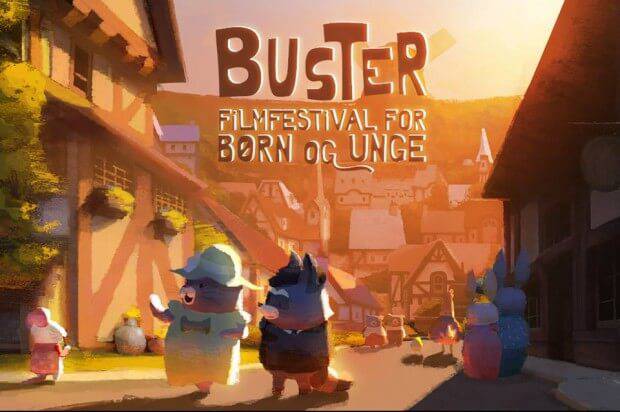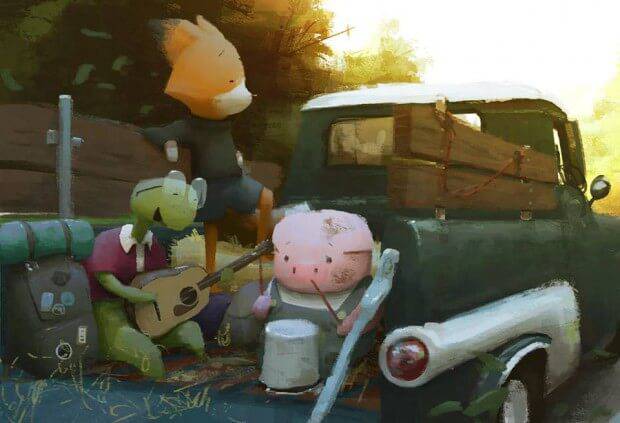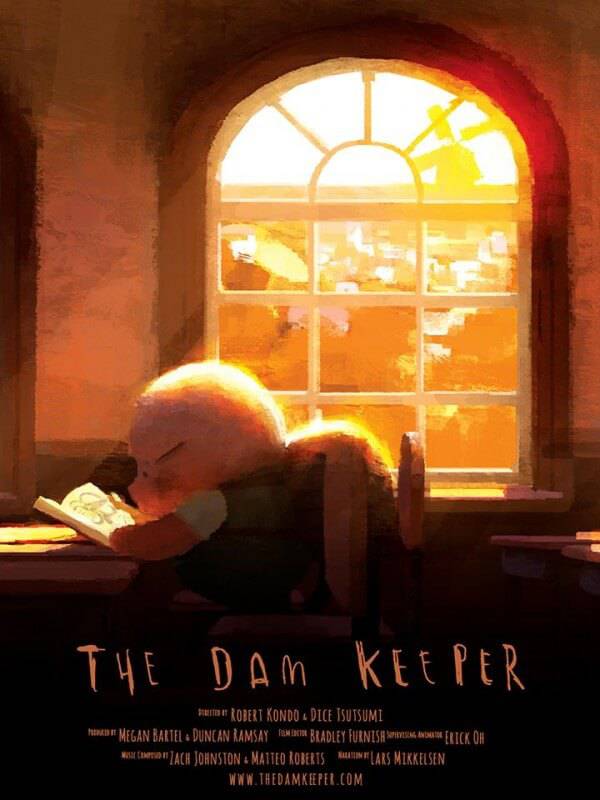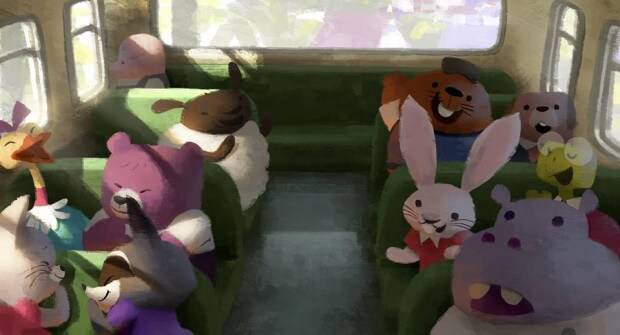Robert Kondo & Dice Tsutsumi: The Dam Keeper Interview
I’ll start the interview by asking you both to introduce yourselves and then we’ll take it from there.
DT: Well, my name is Dice Tsutsumi.
RK: I’m Robert Kondo, and both of us are former art directors at Pixar. We’re directors of a short film we made last year called The Dam Keeper. It’s an 18 minute animated short that’s painted in our styles – we tried to animate a painting basically, and yeah, we’re super happy to be talking to you about it.
I’d like to start the interview by congratulating you both on the success that The Dam Keeper is having. Having seen it myself I can honestly say that all the praise it’s getting is justified. Everyone I’ve seen or spoken to that’s seen it has fallen in love with it, and you only have to go online to see how much people are enjoying it worldwide. How proud are you both to see it doing so well?
RK: Well, first of all thank you so much. You know, it really was a labour of love. It was so much about the two of us learning how to become directors and applying what we had learned at the big feature films studios. So we really didn’t know how it might be received. The community, especially the art and animation communities, have been so supportive and patient given that we’re in this festival “thing”, so really a lot of people haven’t seen it. It’s been amazing that people have been on this journey with us and followed along with us.
DT: Yeah, it was an excitement that we didn’t expect and it’s nice to be in it now because we’ve had a very nice reception of the film. And like Robert said, a lot of people haven’t seen the film but still give it almost, like, such unconditional support, which is tremendous to us.
You said you didn’t really go in with any expectations – what was your first feeling going into the festival circuit? Were you given any advice from people beforehand, or did you go into it blind and just see how it goes?
DT: That’s a good question. I mean, we just wanted to see if we could make a film, period. Both of us had never directed or written a story before and it was important for us to prove to ourselves. And you know, we had a lot of crew members that did their duty on The Dam Keeper for the first time in their career when they would normally do slightly lesser responsibility in their every day jobs. Just the fact we finished it was, we thought, the end of this journey and if we were accepted by any festivals, like one or two, we would be super happy. That was sort of the expectation.
RK: Yeah, it’s so interesting because at the beginning all we wanted to do was finish the film. But finishing the film has changed and the meaning of it has changed over time quite a bit. Especially over the last year. We thought we were done over a year ago. This last year has just been part of the experience – going to festivals has been incredible and especially meeting the independent art community who are so passionate. We’re so excited to even just be a part of it and to actually see all the amazing films that gets done around the world, both live action and animated, really is incredible. It’s been overwhelming. I don’t think we went into it with many expectations. In our film making careers we haven’t ever really experienced that aspect of it and so that’s actually become part of the experience, and even now as we begin to think about how we might release the film to the audience, the project continues to grow. So it’s been really interesting to see what it’s like to finish a project actually.
Now that you have been part of the festival experience, has that changed your mindset going forward with your own, independent studio? Do you think it will change how you approach making a film and marketing it?
RK: Yeah, I think it’s totally changed the way we think about our next films. Especially seeing it in the context of just different audiences. Our film has been made up of audiences of children. We’ve seen it with the animation community. We’ve seen it with an older audience. Just seeing the broad audience and how it reacts to the film really makes us realise more than anything, that anything we do in the future we have to want to do and search internally for stories that are really deep within us, rather than externally going out and seeing what other people want. We really spent a lot of time when developing our future projects just talking to each other and getting to know each other a lot better to find which stories are really at the core of human stories. And so, the interaction with the community out there in the world, in a way, has really gotten us to sit down and dig deeper and want to tell stories from that “place”.
The thing that struck me the most about The Dam Keeper is that the story is very rich and heart-warming and has such an identifiable theme that both young and old can identify with. How did the story come about?
DT: Yeah, what was interesting about how we came about this story was that we didn’t start this project with this story in mind. In fact, we didn’t actually have any story when we started. It was more like, “hey, you wanna make a short film together and see what we can do?” and just see where the limit was. It really took us quite a bit until we got to a stage where we could call it The Dam Keeper. We had a list of about four or five stories because beforehand the idea wasn’t the focus of the project – it was more about can we work together and can we do something together that we didn’t think at the beginning we were able to do.
RK: Yeah, this is our first time directing together. It’s almost the first time we’ve sat down and wrote something together. We made a lot of films together back when we were at Pixar and we collaborated really well, but writing something together is completely different. I always think of it as two artists trying to hold the same pencil and make a drawing. There’s a lot of things to work through in terms of who we want to be as directors and ego can get in the way, obviously.
Coming from a large studio, one of our missions was to run a healthy production and our first mantra that we kept chanting as we went into production was, “let’s lock the story before we get into production”. A lot of big studios suffer when they don’t lock the story, or continue to work on the story once production has started. We always saw it as this costly thing and we said we were not going to do that. We found out though it was actually close to impossible to avoid that. Now we realise there’s something actually great that happens with the dynamic between production and story evolution, and also getting the crew involved so that they were not just executing but they were also participating in the story we were going to tell. In hindsight, that’s part of the film making process that both of us are really proud of.
So what would you say was the biggest difference from working at Pixar to writing and directing your own short film?
RK: Both of us are art directors – we’ve worked on Toy Story 3 and Monsters University together as art directors – and we came from the art department which is a small part of this “big machine”. When you’re working on that small part you really feel like you want to put everything you have into that painting, or into the sequence you’re lighting, and you just pour your heart and soul into this thing. You even invent little stories behind every little prop and every little decision you make you go and present to the director. Working in film on a big scale like that always made me feel like what I was doing was so important. However, directing a film on our own really gave us context for where we actually fit in the film making process. So, it was really humbling to direct and realise that actually in the process of making the film we probably spent the least amount of time on the design and artwork of the film. We spent so much time in story, camera, editorial and it was a humbling thing to see the part we play in the “big machine” versus being in the drivers seat and seeing for yourself where you fit in that process.
The art direction of the film is simply gorgeous. Was it a conscious effort on your part to go with that style and avoid using a typical 3D look that you might see in a Pixar or Disney movie?
DT: Honestly, I think that was because we didn’t have the resources to do it in 3D, and at the beginning we really didn’t know how many people were going to help us as it was just the two of us. We thought if we could do as much as we can by ourselves, then that would be the best way to finish this project. We know how to paint and if the film looks like our painting, then maybe that is the easiest approach. It wasn’t so much of a statement to say we’re going to do something different. Of course we believed in this animated painting style – we really loved that. But at the same time we were focused so much on telling this particular story we wanted to tell, it was almost out of necessity that we chose that style.
RK: Also before we began, the year before Dice had made a small animation for his project Sketchtravel that he had worked on and it was almost like a small advertisement in style. Dice had done all the production himself and it was like a children’s book with limited animations, so we thought if there were two of us on The Dam Keeper, we could do twice as many frames. Of course, as we moved through the project and our vision got more and more ambitious, we got involved with a higher number of talented people and artists.
So do you think you would like to experiment with other mediums for future projects?
RK: Yeah, we’re such fans of animation. Even live action we’re fans of. More than anything I think that we hope as we move forward, the projects me make continue to give us more opportunities to experiment and play. We realise that embracing the limitations that we had led to something that actually turned out to be a good thing. I always believe it’s not so much about the execution of these looks, so much as capturing the feeling of the kind of work we want to do. We want to pick mediums and looks that are appropriate to the type of story we want to tell.
Now you have experienced working both at a big studio and independently, what would you say are the biggest changes, be it good or bad?
RK: I think both of us have been incredibly blessed to work in the large studios. The studios have some of the most amazing artists I think you can find in the world, so getting to go to a place where you’re collaborating with hundreds of artists is an incredible experience. I’ve learned so much and benefited so much from working there. And I still have so many friends and people that we respect that work in that industry. I’d say that all of it is a learning experience. Going from school into the larger studios was a good continuation of my education. I came from an illustration background and had a niche skill that applied to what Pixar wanted to make at that time, so again, it was a great entry point for me into film making. While I was at Pixar I got to see all the parts I wanted to see to get to the point where I realised that I really wanted to make my own films. I met Dice there, and Dice had this similar ambition. In a way when I look back and at a studio that big, you really can utilize and capatolize these unique skills you might have. It’s also a great place to meet people that are capable of doing that on a larger scale and apply those things that you’re really good at and build the rest of your skill set.
Independent film making is great because you’re in there making film all the time. You’re practicing. You’re stumbling and falling. I don’t know what it would have been like for me to start out as an independent film maker, but I’m super happy with where I’ve been and the people I’ve met and the experiences that I’ve had. And to be here now as an independent film maker, I feel like we’re armed with all of these experiences from the big studios to go and make our film.
We didn’t study animation in school. Both Dice and I come from more of a traditional painting background and there was a lot of exposure we needed from the animation world and the film making world that the large studios were great at providing us with.
So coming from a traditional painting background, do you think that your style was unique to Pixar at the time? Or were there artists there who utilized that style and helped you develop?
DT: I think we believe the designing of film is about communicating your ideas to the director and the crew and then ultimately to the audience, and artistic style doesn’t really matter. Unfortunately there are still people looking at portfolios who are only applying what they know. Ultimately visual development art work doesn’t make it into the final film and you can only do so much to help communicate, but unfortunately some people make the mistake of thinking they have to have a particular look to work for animated feature which we don’t believe is the way it should be.
RK: Yeah, I think focusing too much on style is always tricky because we’re really trying to tell stories that stand the test of time and the trickiest thing for me about style, is it’s always about what’s here and now. Style is like handwriting in that I can’t help the way I write, it is what it is. But the words I write are hopefully what the world focuses on rather than the way I write. We have thought of style of course, but in terms of the list of priorities it’s probably close to the bottom.
DT: Ultimately the style is who you are but at the same time it’s not actually something you can work on, because that’s who you are and it’s your life experiences that come into play.
And is that something you have learned from directing yourselves?
RK: For me, day one at Pixar made that super clear. In the hallways at Pixar they would always say, “we make movies, not art books”, and that’s something that always stuck with me. I think the industry from day one is all about film making. So if a person is working on some material on a table, the ‘best of’ are always thinking about how that fits into the film and how it progresses the story forward.
So going back to The Dam Keeper, one of the things I loved the most is the marketing artwork that you have done for your official The Dam Keeper Facebook page, which again highlights the attention to detail on this film. We those designs a conscious effort from the beginning?
DT: Well what’s interesting is that the first film festival we got entered into was the Berlin Film Festival and we were super excited to be in such a major film festival. So I did one illustration just to share the news with our followers on our Facebook page, and then we got into another one, and another one, and then somehow along the way we started to do an illustration each time we got entered into festivals. Of course to this day we’ve been accepted into sixty five festivals, which we did not expect at all when we started.
RK: I think it’s one of those things that started to define who were wanted to be as Tonko House [Tonko House is our new company that we’ve just started], and I think that’s a good example of this commitment that we made without knowing it but at the same time knew there was a small group of people that started to expect it. It’s a great thing but it’s also an incredible amount of work and actually we are now bringing back some of our amazing painting team from The Dam Keeper to help us. As we move forward we really want to be people that are able to say “ we committed to that” and really see through commitments that we made.
So now that you’re at your studio, Tonko House, what are your plans moving forward? Will you continue to work together?
RK: Well we’re definitely going to be working together and we’re really just trying to figure out what the next best step is for us. We want to continue telling stories. We want to build upon what we’ve done on The Dam Keeper. It’s great visiting the film festivals but it’s getting harder and harder to watch the film for ourselves because we’ve grown since then and I think we look at it and think we can do so much better now. We can make it bigger, better, a longer format. So right now, we’re really giving ourselves some time to sit down and really start digging into who we are as people and what stories we’re really capable of telling. We love world building and building these fun, fantastic, believable worlds and I think we want to just keep doing that. One thing that Dice has always talked about is to think about the kind of impact from the stories we’re going to be telling. What is the impact of the kind of stories we want to tell, both in content and also with regards to what a film can do for a small or large community.
DT: One thing we always talked about was to always understand why we are doing this. Let’s not just focus on what we’re doing, but also why we’re doing it. It’s actually harder than we expected because every time we get excited about one of our stories we back track and make sure truly understand why we’re doing that. We want to make sure we left Pixar for a reason and went to Tonko House for a reason.
RK: And I think we’re at a unique place that we know won’t last forever, where no one has told us that we can’t do it. So we’re trying to embrace that and keep doing what we enjoy doing without looking back.
You have also started teaching an online art class at Schoolism. Is teaching something you’ve always wanted to do?
RK: Teaching has always been a part of our conversation. Even on The Dam Keeper we brought on a lot of young artists who showed the promise of being great artists but hadn’t been given the opportunities yet. We felt that bringing what we know as painters to them and seeing them grow was probably one of the most rewarding parts of making The Dam Keeper. We realised that education is an important part of what we would do in the furture.
We met Bobby Chu (who runs Schoolism) as well as the rest of the Schoolism family, and seeing their vision of where they want to go and seeing what a great environment it is for creative professionals to be working in, made it really easy for us. We’re in the middle of making those online courses now. It’s an important thing not only to interact with the people who are that hungry to grow and learn from our experiences, but overall I think that’s what Tonko House wants to do.
DT: We’re approaching online teaching as seriously as making a film, because ultimately we’re communicating with people and we want it to feel like we’re sharing it with them and treat each member like a future Tonko House employee.
Would you say the industry has changed much [in your mind] since you began as professionals?
RK: I think the internet changes a lot of things, but it also provides a lot of things that weren’t there before. I think the ‘game’ itself is changing. Hollywood’s changing. The industry’s changing. But at the core of it, what’s most important hasn’t really changed at all, which is good story telling and good film making.
DT: The technology is actually allowing more voices to be heard and we can actually start to see a shift in the industry which we’re very excited about.
Leading onto my final question, now that you have worked at both Pixar and Tonko House (and experienced the differences between the two), what is the best piece of advice you have for students and professionals that are looking to establish themselves in the industry?
RK: Looking back, what I’ve benefited from the most is embracing change. Because the industry is constantly changing, it’s really important to be able to see an opportunity, whilst having a grand vision for where you actually want to go, and then seeing how those opportunities might fit. The ability to adapt, especially in the world we’ve just talked about, is fundamentally the most important thing. Looking back, I find pockets of my time were spent worrying more about the ‘what’ or the ‘how’ rather than the ‘why’ and staying focused on where I wanted to go. When Dice and I left Pixar, we spent a tonne of time talking about the ‘why’. “Why are we leaving?”. “Why are we making films?”. And I have to say that it’s focused us so quickly on where we want to go and what we want to do. I wish I’d done that a lot more in my career, even when I was back at school I wish I’d done that more.
DT: Well I think that focusing on the ‘why’ part helps focus on the process rather than the result. In the early part of your career, it’s very easy to be discouraged by the result and questioning where you fit in. It’s important that you don’t get distracted by the results but rather look at the journey itself so that you’re moving forward. Most of the time, the result is out of your control but the process is in your control.


